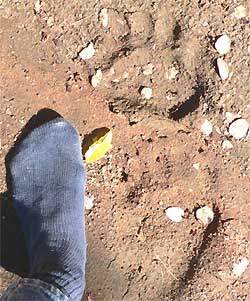Excerpts from Jim Conrad's
Naturalist Newsletter
from the August 8, 2005 Newsletter issued from the Sierra Nevada foothills
somewhat east of Placerville, California, USA
BEAR PRINTS
The dry season is bearing down on us and the grassy, wildflower-graced slopes are now brittle and hay- colored with only deep-rooted trees and shrubs remaining green. The gravel and dirt roads upslope in El Dorado National Forest are developing stretches of deep dust and what's good about that is that dust is as good for tracking critters as snow. Therefore, when I wandered into the mountains this week my radar was set to animal tracks.
I really wanted to see porcupine tracks, for I have no experience with that animal and porcupines are found here. Fred saw one years ago beneath some brush but they're not common, and I found no sign of them during my hike. In dust their tracks would be easy to identify because their quills scrape the ground at the sides of their prints.
That dust told enough stories to keep me fascinated during the entire hike. Jackrabbits, foxes, coyotes, raccoons, squirrels, beetles, lizards, quail, deer, snakes, and several things I couldn't identify, all left signs of having done nearly everything other than walk in a straight line.
 I'd grown accustomed to the tracks' smallness, the largest ones being the deer's, so when bear prints suddenly appeared below me it was breathtaking. The back paw prints were 7½ inches long, not counting claws, which weren't visible, and 3½ inches broad. They looked unsettlingly like human prints, just much wider, plus the biggest toe was on the outside of the foot, not as among humans. [The shot at the right is of prints found later, in mud.]
I'd grown accustomed to the tracks' smallness, the largest ones being the deer's, so when bear prints suddenly appeared below me it was breathtaking. The back paw prints were 7½ inches long, not counting claws, which weren't visible, and 3½ inches broad. They looked unsettlingly like human prints, just much wider, plus the biggest toe was on the outside of the foot, not as among humans. [The shot at the right is of prints found later, in mud.]
While measuring the prints my own hands placed near those massive, plodding tracks looked spidery and weak. For a moment I glimpsed how early people with simple arms must have felt when tracking a bear.
A few minutes later I came upon a shoulder-high Douglas-fir sapling right beside the road. It had been clawed and possibly chewed on one side so that its bark and wood hung in shreds. Copious resin exuded in gummy droplets, and I suspect that that's what the bear had been after. When I tasted the resin at first there was a hint of sweetness but then there was no flavor at all other than that of turpentine.
It's hard to imagine enough food being available at this time of year to keep a large bear going. It's too early for manzanita fruits and blackberries, and only a few undersized acorns are falling. We were over a mile from any water. About all I could think of that a bear could eat were grubs in decaying logs and ants beneath rocks. I've seen Pileated Woodpeckers extract thumb- size grubs from old logs, and I know that some very large ants with their white pupae live beneath our rocks. Black Bears are known to relish ants, which they eat in masses. Bears also eat roots and tubers, plus there must be the occasional honey tree. Down below, Diana tells me she's just seen some bear poop full of plum pits, apparently from a neighbor's orchard tree. Still, I think our bears must be pretty hungry these days.
The next day, backtracking, I came upon a second, slightly smaller set of tracks. Moreover, in the section of dust where they appeared they lay exactly atop my own tracks of the previous day, and going in the same direction. Was it a coincidence, or was that bear tracking me...?
 I'd grown accustomed to the tracks' smallness, the largest ones being the deer's, so when bear prints suddenly appeared below me it was breathtaking. The back paw prints were 7½ inches long, not counting claws, which weren't visible, and 3½ inches broad. They looked unsettlingly like human prints, just much wider, plus the biggest toe was on the outside of the foot, not as among humans. [The shot at the right is of prints found later, in mud.]
I'd grown accustomed to the tracks' smallness, the largest ones being the deer's, so when bear prints suddenly appeared below me it was breathtaking. The back paw prints were 7½ inches long, not counting claws, which weren't visible, and 3½ inches broad. They looked unsettlingly like human prints, just much wider, plus the biggest toe was on the outside of the foot, not as among humans. [The shot at the right is of prints found later, in mud.]